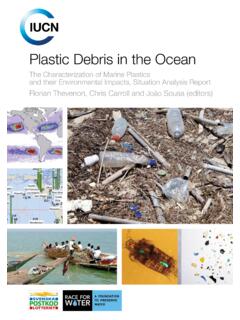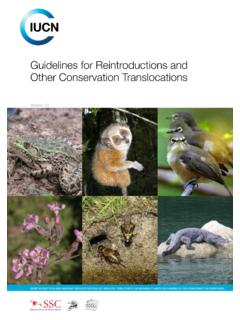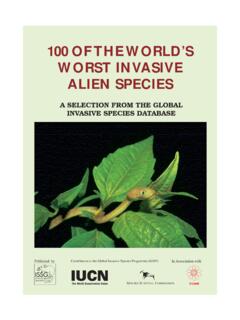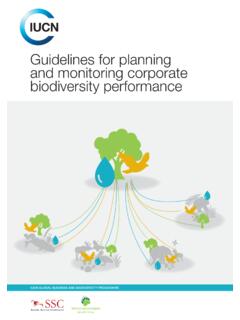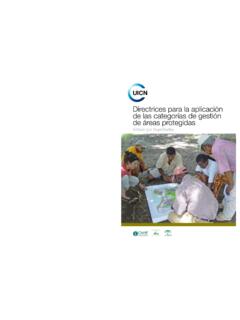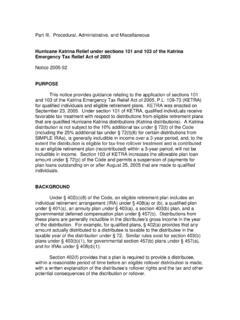Transcription of Nature-based Solutions to address global societal challenges
1 Nature-based Solutions to address global societal challengesEditors: E Cohen-Shacham, G Walters, C Janzen, S MaginnisNature- based Solutions to address global societal challengesEditors: E Cohen-Shacham, G Walters, C Janzen, S MaginnisThe designation of geographical entities in this book, and the presentation of the material, do not imply the expression of any opinion whatsoever on the part of the International Union for Conservation of nature (IUCN), the government of the United Kingdom or other participating organisations concerning the legal status of any country, territory, or area , or of its authorities, or concerning the delimitation of its frontiers or boundaries. The views expressed in this publication do not necessarily reflect those of IUCN or other participating report has been produced by IUCN, funded by United States Voluntary Contribution (United States Department of State), Norad, BMUB-IKI, and UNDP-GEF. Published by: IUCN, Gland, Switzerland Copyright: 2016 International Union for Conservation of nature and Natural Resources Reproduction of this publication for educational or other non-commercial uses is authorised without prior written permission from the copyright holders provided the source is fully acknowledgedReproduction of this publication for resale or other commercial purposes is prohibited without prior written permission of the copyright holders.
2 Citation: Cohen-Shacham, E., Walters, G., Janzen, C. and Maginnis, S. (eds.) (2016). Nature-based Solutions to address global societal challenges . Gland, Switzerland: IUCN. xiii + : 978-2-8317-1812-5 DOI: photos: (From top to bottom, left to right): Viticultural landscape, France; Seed sower, Jordan; Wetland, East USA; Coastal area , West coast, USA; Conserved watershed forest, Guatemala; Women farmers, Savannah, Gabon; Mangroves, Costa Rica; Fishermen, Gabon; Watershed, Canada Jordan photo credit: IUCN ROWA. All other photos are from Gretchen Walters and Emmanuelle Cohen-ShachamBack cover photos: Rocky Mountains, USA. Photo credit: Emmanuelle Cohen-ShachamPhoto in Part A: Humid forest, Gabon. Photo credit: Olivier HymasPhoto in Part B: Transporting mangrove seedlings for planting, Costa Rica.
3 Photo credit: Marco QuesadaLayout by: Chadi Abi ( )Editing by: Jennifer Rietbergen-McCrackenGraphics by: Studio EshkatAvailable from: IUCN (International Union for Conservation of nature ) global Forest and Climate Change Programme Rue Mauverney 28 1196 Gland Switzerland iiiiiiTable of ContentsList of Tables and Figures ..List of Acronyms ..Explanation of Icons ..Main Contributors ..Acknowledgements ..Preamble ..Executive Summary ..Part A - Nature-based Solutions : From Theory to Practice .. 1. What are Nature-based Solutions ? .. Development of the NbS concept .. Origins of NbS .. Current status of the NbS concept .. Milestones in the development of NbS.
4 Defining NbS .. Multiple definitions of NbS .. A proposed definitional framework for NbS .. Applying the NbS concept: an introduction .. What does NbS look like in practice? .. A typology of NbS applications .. NbS as an umbrella concept for ecosystem-related approaches .. NbS initiatives at IUCN .. 2. Nature-based Solutions to specific societal challenges .. Nature-based Solutions for water security .. Nature-based Solutions for food security .. Nature-based Solutions for human health .. Nature-based Solutions for disaster risk reduction .. Nature-based Solutions for climate change .. How natural capital approaches relate to NbS ..viviiviiiixxxixii122234555779101012121 213141516ivivNature- based Solutions to address global societal challenges 3. Ecosystem-related approaches within the NbS family .. Ecosystem restoration approaches .. Ecological restoration .. Ecological engineering .. Forest landscape restoration.
5 Issue-specific ecosystem-related approaches .. Ecosystem- based adaptation .. Ecosystem- based mitigation .. Climate adaptation services .. Ecosystem- based disaster risk reduction .. Green infrastructure and natural infrastructure approaches .. Ecosystem- based management approaches .. A brief comparison of these NbS approaches .. 4. Lessons learned from the case studies .. 5. Toward an operational framework for NbS .. The need for an operational framework for NbS .. Ecosystem Approach as the basis for an NbS operational framework .. What should a single operational framework deliver? .. Determining the key parameters of an NbS operational framework .. Proposed operational parameters for NbS .. 6. Concluding remarks ..Part B Case Studies: Nature-based Solutions on the ground Introduction to the case studies .. Case Study 1 USA: Restoration of Cache la Poudre River to recover ecological function and reduce flood risk in Fort Collins, Colorado.
6 Case Study 2 Japan: Wetlands and rice paddy fields contribute to biodiversity conservation, flood control and the local economy .. Case Study 3 UK: A collaborative approach to managed realignment of coastal defences in South-East England .. Case Study 4 Rwanda: Forest Landscape Restoration as a national priority .. Case Study 5 Ecuador: One landowner s approach to forest restoration and sustainable management .. Case Study 6 Jordan: Securing rights and restoring lands for improved livelihoods ..17171717181818191920202222252727282930 30323334374145505559vv Case Study 7 Costa Rica: Securing livelihoods through mangrove conservation and restoration .. Case Study 8 USA: Restoration of wetlands and barrier islands for storm protection in the Northern Gulf of Mexico.
7 Case Study 9 Spain: Developing the Barcelona Green Infrastructure and Biodiversity Plan .. Case Study 10 Guatemala and Mexico: Implementing transboundary water governance through community ecosystem- based action in the Tacan watersheds ..References ..Annex 1: NbS approaches: definitions and related terminologies ..Annex 2: Linkages and relationships between NbS approaches ..64687276819195viviNature- based Solutions to address global societal challengesList of Figures and TablesList of Figures Figure 1. Forests and their restoration as Nature-based Solutions that can complement other measures to address , in this case, food securityFigure 2. Timeline of the development of the NbS conceptFigure 3. Establishing a definitional framework for NbS, to support the development of standards for NbS applicationsFigure 4.
8 Hypothetical scenario of Nature-based Solutions being used in conjunction with infrastructure developmentFigure 5. A typology of NbS showing three main categories of Solutions based on natural, restored and new ecosystemsFigure 6. NbS as an umbrella term for ecosystem-related approachesFigure 7. Natural infrastructure for water managementFigure 8. Trends in number of research papers mentioning NbS approaches (1980-2014)Figure 9. Map of case study locationsList of TablesTable 1. IUCN s and the European Commission s definitions of NbSTable 2. Clarification of terms used in the NbS definitional frameworkTable 3. Foundational ideas used in the development of NbS principlesTable 4. Categories and examples of NbS approachesTable 5. Case studies presented in the reportviiviiList of AcronymsAFOLU Agriculture, Forestry and Other Land UseCAS Climate Adaptation ServicesCBD Convention on Biological DiversityCORNASAM Inter-Institutional Coordination for Natural Resources and the Environment (Guatemala)CO2 Carbon dioxideEbA Ecosystem- based AdaptationEbM Ecosystem- based MitigationEbMgt Ecosystem- based ManagementEco-DRR Ecosystem- based disaster risk reductionEDPRS Economic Development and Poverty Reduction Strategy (Rwanda)EE Ecological EngineeringER Ecosystem (or Ecological) RestorationFLR Forest Landscape RestorationFONERWA National Climate and Environment Fund (Rwanda)
9 GI Green InfrastructureIUCN International Union for Conservation of NatureIWRM Integrated Water Resource ManagementMINIRENA Ministry of Natural Resources (Rwanda)MStAG Medmerry Stakeholder Advisory Group (UK)NbS Nature-based Solution(s)NCAP Natural Capital ApproachNI Natural InfrastructureRamsar Convention on Wetlands of International ImportanceREDD+ Reducing Emissions from Deforestation and forest Degradation +RNRA Rwanda Natural Resources AuthorityROAM Restoration Opportunity Assessment MethodologyRSPB Royal Society for the Protection of Birds UNDP United Nations Development ProgrammeUNFCCC United Nations Framework Convention on Climate ChangeWANI Water and nature InitiativeWRI World Resources InstituteviiiviiiNature- based Solutions to address global societal challengesList of IconsSocietal challenges Climate ChangeDisaster RiskFood SecurityHuman HealthWater SecurityEconomic and Social DevelopmentNbS conceptsEcological RestorationEcosystem- based AdaptationEcological EngineeringEcosystem- based MitigationForest Landscape RestorationEcosystem- based disaster Risk ReductionGreen
10 InfrastructureClimate Adaptation ServicesNatural InfrastructureArea- based ConservationEcosystem- based ManagementixixMain ContributorsThis report was prepared in a highly collaborative manner, drawing on the expertise of numerous people from within IUCN, its Commissions and Members, and other organisations including NGOs, research institutes, governmental bodies and private sector businesses. The principal authors and editors of the report are Emmanuelle Cohen-Shacham (IUCN s Commission on Ecosystem Management Ecosystem Services Thematic Group), Gretchen Walters (IUCN s global Forest and Climate Change Programme), Christine Janzen (Brock University and Commission on Ecosystem Management) and Stewart Maginnis (IUCN s Nature-based Solutions Group).Contributors for specific sections of Part A of the report are as follows: Angela Andrade, Commission on Ecosystem Management Nigel Dudley, Equilibrium Research and IUCN s World Commission on Protected Areas Marie Fischborn, IUCN s Protected area Solutions Group Mike Jones, Swedish Biodiversity Centre and IUCN s Commission on Ecosystem Management Resilience Thematic Group Chetan Kumar, IUCN s global Forest and Climate Change Program Penelope Lamarque, IUCN s Nature-based Solutions Group Constanza Martinez, IUCN s global Policy Unit Radhika Murti, IUCN s Ecosystem Management Programme Nathalie Olsen, IUCN s Economic Program Sandeep Sengupta, IUCN s global Policy Unit Mark Smith, IUCN s global Water Programme Chantal van Ham, IUCN s European Regional Office Rebecca Welling, IUCN s global Water ProgrammeContributors for the case studies in Part B are as follows.





